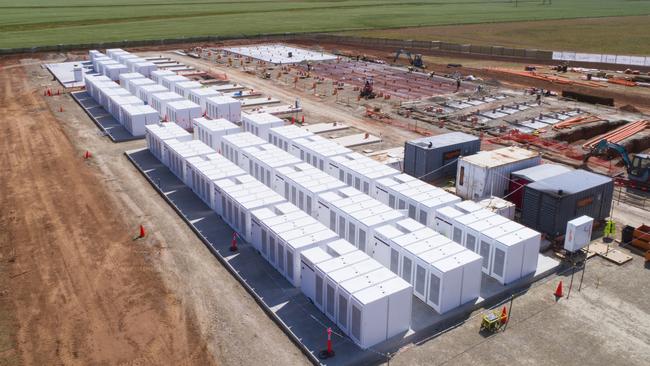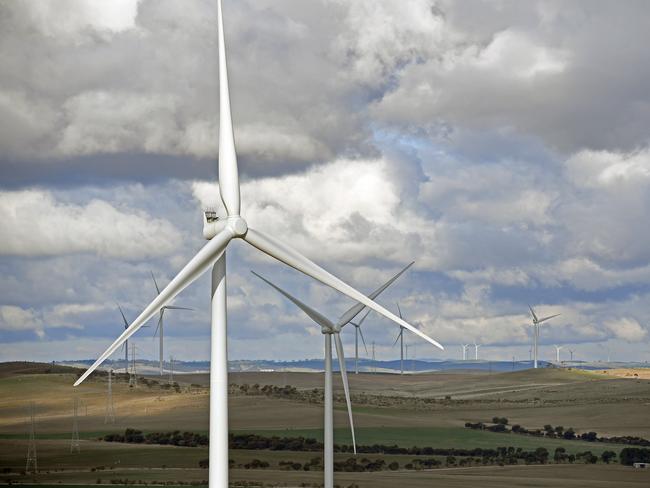Neoen to increase size of Jamestown Tesla battery array by 50%, saving $47m on SA electricity bills
The world’s largest lithium-ion battery is about to get even bigger, meaning South Australians will collectively save nearly $50m on their power bills.
SA News
Don't miss out on the headlines from SA News. Followed categories will be added to My News.
- Giant Jamestown battery is finally switched on
- Get more out of your Advertiser digital subscription
- Neoen to build tallest wind farm, solar and big battery at Crystal Brook
South Australian consumers will save $47 million a year from the price they collectively pay for electricity with the world’s biggest battery, at Jamestown in the Mid North, to get even bigger.
French company Neoen will increase by 50 per cent the size of the lithium-ion Tesla battery array and, in a global-first, provide stabilisation services equivalent to the biggest coal-fired power stations in Australia.
The battery, called the Hornsdale Power Reserve, has already cut $40 million a year from electricity costs through its efficient service supporting electrical frequency in the grid.
“The Tesla big battery has been a great story and an incredible project for us,” Neoen Australia’s managing director Louis de Sambucy said.
“This is the second stage of the project — the battery is not only getting bigger, it’s getting smarter.”
The battery would provide key services in driving lower prices and greater reliability, he said.
It would provide 50 per cent of SA’s needs for inertia in the system, a world-first provision at this scale.

Inertia, traditionally provided by the rotation of large turbines, was like a shock absorber in a car, Mr de Sambucy said.
It automatically smoothed out fluctuations and improved the quality of electricity supply.
In addition, the battery would work in harmony with interstate interconnectors to achieve their carrying capacity and it would help reduce the amount of currently wasted energy when there is a surplus of supply and wind farms have their output curtailed.
Mining and Energy Minister Dan van Holst Pellekaan said the project was part of SA’s nation-leading position in the energy transition.
“The expansion of the big battery is expected to lead to significant savings by allowing SA to use even more renewable energy to lower prices in a secure fashion,” he said.
“This expansion will support our transition to net 100 per cent renewable energy and show the world a better way to manage the transition.
“We know the existing Hornsdale battery has saved consumers $40 million per year since its inception.

“This 50 per cent increase to capacity plus the additional services we will receive will add an additional $47 million per year of savings.”
The SA Government will pay Neoen $15 million from the Grid Scale Storage Fund, in instalments over five years as services are verified.
The Federal Government’s Australian Renewable Energy Agency will provide an $8 million grant toward the project which cost $60 million to $80 million.
ARENA chief financial officer Ian Kay said a requirement would be that knowledge gained from the project must be shared.
It also would pave the way for evaluating the services with a view to monetising them with appropriate regulatory change.
Federal Energy and Emissions Reduction Minister Angus Taylor said the battery’s cheaper support services would ultimately result in savings for consumers.
“Projects like this, combined with the gas and pumped hydro projects that are coming online, are extremely important to the future integration of renewable energy to the SA grid,” Mr Taylor said.
The existing $90 million Hornsdale Power Reserve has capacity of 100MW/129MWh energy storage.

The expansion will add 50MW/64.5MWh.
Work on site is already under way by Adelaide company Consolidated Power Projects.
The construction workforce will peak at about 80 jobs.
The battery is attached to the 316MW Hornsdale wind farm, which cost some $500 million to build.
The expansion was not surprising, said Marija Petkovic, managing director of consultants Energy Synapse.
Batteries could respond to frequency issues within 100 milliseconds, far faster than traditional minimums of 6 seconds, she said.
“This will be even more important as the ageing coal plants exit the system,” she said.
In addition to ARENA grant, the federal Clean Energy Finance Corporation will provide up to $50 million in project financing.
---------------------------------------------
HOW IT WORKS
A common misconception about the big battery is that it is only there to be plugged in when there’s a blackout.
Critics lambast it, saying it would only keep the lights on for a moment.
In fact, it could discharge at full 100MW for 75 minutes, which would be enough to fire up a network of generators.
But where the battery is really saving South Australians money — and making its French owners a very good return — has been in providing frequency control services to the grid.
A report by Australian Energy Market Operator said the battery was providing “rapid and precise” frequency control services, in fact of a higher quality than provided by traditional fossil-fuel power stations.
Engineering firm Aurecon estimates South Australians are saving $40 million a year because the battery has reduced the level of services which must be bought to ensure grid stability.
Analysis by independent consultants Energy Synapse found the battery made at least $3.4 million in September alone — its best ever month.
This was principally through frequency control services which are needed to compensate both for the variability of renewable energy and the increasing occurrence of fossil-fuel power stations breaking down, particularly the ageing coal fleet.
Now, it will provide even more support services to the grid — inertia and support for the interconnector and wind farms.
Construction of the battery was underpinned by a State Government contract in 2017 which
sparked the famous Twitter exchange where Australian tech entrepreneur Mike Cannon-Brookes alerted Tesla boss Elon Musk, who tweeted he could build the battery in 100 days or it would be free.
Consumers are justifiably highly sceptical about all the claims of bill savings from this and other initiatives.
The proof will come over time but the transition to renewable energy is already showing a downward trend in wholesale prices which will eventually flow through to hard-pressed consumers.
